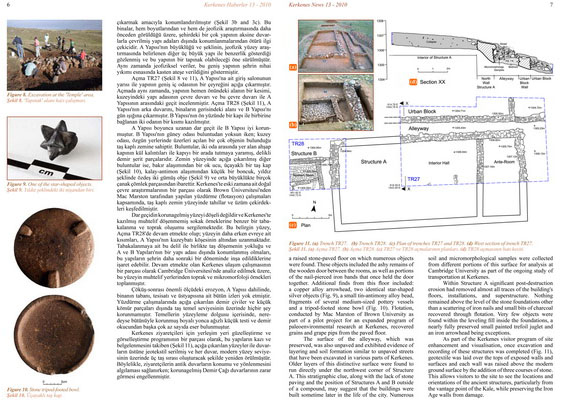| |
Preservation was excellent within Structure B and along the alleyway running alongside Structure A. While the southern room of Structure B was largely devoid of finds, the northern room had a raised stone-paved floor on which numerous objects were found. These objects included the ashy remains of the wooden door between the rooms, as well as portions of the nail-pierced iron bands that once held the door together. Additional finds from this floor included: a copper alloy arrowhead, two identical star-shaped silver objects (Fig. 9), a small tin-antimony alloy bead, fragments of several medium-sized pottery vessels and a tripod-footed stone bowl (Fig. 10). Flotation, conducted by Mac Marston of Brown University as part of a pilot project for an expanded program of paleoenvironmental research at Kerkenes, recovered grains and grape pips from the paved floor.
The surface of the alleyway, which was preserved, was also unpaved and exhibited evidence of layering and soil formation similar to unpaved streets that have been excavated in various parts of Kerkenes. Older layers of this distinctive surface were found to run directly under the northwest corner of Structure A. This stratigraphic clue, along with the lack of stone paving and the position of Structures A and B outside of a compound, may suggest that the buildings were built sometime later in the life of the city. Numerous soil and micromorphological samples were collected from different portions of this surface for analysis at Cambridge University as part of the ongoing study of transportation at Kerkenes.
Within Structure A significant post-destruction erosion had removed almost all traces of the building's floors, installations, and superstructure. Nothing remained above the level of the stone foundations other than a scattering of iron nails and small bits of charcoal recovered through flotation. Very few objects were found within the leveling fill inside the foundations, a nearly fully preserved small painted trefoil juglet and an iron arrowhead being exceptions.
As part of the Kerkenes visitor program of site
enhancement and visualisation, once excavation and
recording of these structures was completed (Fig. 11),
geotextile was laid over the tops of exposed walls and
surfaces and each wall was raised above the modern
ground surface by the addition of three courses of stone.
This allows visitors to the site to see the locations and
orientations of the ancient structures, particularly from
the vantage point of the Kale, while preserving the Iron
Age walls from damage.
|



